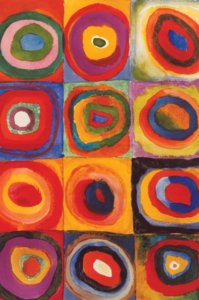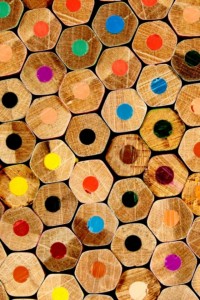Inspiring Interior Design (Part 18)
By Asher Crispe: August 29, 2012: Category Inspirations, Quilt of Translations
The Emotive Spectrum Continued…
 Compared with the ‘simplicity’ of the primary colors and emotions, the secondary ones will require considerably more explanation. Beyond the individual emotive qualities represented by these three colors, we also have to think through the reasons for their being born of a particular synthesis of primary colors and emotions.
Compared with the ‘simplicity’ of the primary colors and emotions, the secondary ones will require considerably more explanation. Beyond the individual emotive qualities represented by these three colors, we also have to think through the reasons for their being born of a particular synthesis of primary colors and emotions.
The secondary emotions and colors:
Violet / Purple (Sagol) relates to the word segulah meaning a ‘treasure,’ ‘object of value,’ ‘virtue’ or even a ‘healing power.’ At times this special trait or characteristic implies a kind of theurgy or supernatural magical ability. The compounding of several of these definitions applies to the nation of Israel as evidenced in a verse from Exodus (19:5) “…you shall be My special treasure (segulah) among all peoples.” Thus violet / purple (often taken to be the color of royalty throughout the ages) reflects a mark of exemplary character or uncanny abilities.
Since this color is a mix of blue and red we can understand it as a blend of lovingkindness and severity. The problem is that these definitions don’t quite make sense in this context. When the kabbalists meditate on the powers of the soul as a whole (or in this case just the powers that pertain to the emotions) they often have to look through a kaleidoscope which is slowly turned to reveal the right viewing angle so that the definitions of the terms of the relationship click into place.
In our case, we need to think of lovingkindness as an emotion that transcends limits. Judgement or severity is predicated upon limits. This is like saying that love goes beyond distinctions. The attraction extends beyond boundaries right up into the infinite itself. Pure love is an expression of the limitless or ayin sof. It knows no barriers. It suspends judgments. On the other hand, severity (gevurah) is all about the enforcement of limits. For this reason it involves judgement: Does the recipient deserve this or not? The ultimate self-limitation enacted in the world is the Divine contraction wherein the infinite aspect of Divinity was concealed and the finite aspect was revealed. This manifest finitude gave rise to the limitations within Creation such as time and space.
So what happens when you mix infinite love with limiting judgements? If we think of this just in terms of temporality, then we are speaking of the intersection of the temporal and the eternal (above time). The power of the soul which expresses this combination is netzach. Netzach means both nitzchiut (eternity) and nitzachon (victory). Eternity is the victory over time. To continually counter and transcend the erosion of time would be to taste the timeless within time itself–to overcome time through time. The fusion of these definitions amounts to something like ‘endurance’ or ‘perseverance.’
In the first book of Shmuel (Samuel I15:29) we find the expression: “And also the Eternal one [netzach] of Israel does not lie or change His mind….” The text actually reads more like ‘the quality of overcoming time, the enduring quality of Israel.’ Israel has the unique ability to overcome adversity and endure. Despite all the obstacles of time– the historical forces that have sought to extinguish Israel–this nation overcomes all of these challenges. Israel wins out over time itself by joining the limited to the unlimited, the temporal to the eternal. The segulah or supernatural quality of Israel is precisely the ability to keep going with the confidence and trust (bitachon is the inner experience of netzach) that we will ultimately succeed and endure. Facing the judgements of history we must nonetheless use the love of the infinite to overcome. Red mixed with blue yields violet / purple.
Orange (katom) can be broken into two parts: ka-tom. ‘Ka’ acts as a prefix meaning ‘like’ or ‘as’ while tam means ‘complete,’ ‘perfect,’ ‘whole,’ ‘innocent’ and ‘simple.’ It can also be regarded as the basis for the word temimut or ‘integrity’ and ‘innocence.’ To do things whole-heartily and sincerely is the inner experience of the soul power known as hod. Hod carries the sense of ‘thanksgiving’ (hodayah) and ‘acknowledgment’ (hoda’ah) as well as ‘splendor’ (as in the expression: the ‘splendor of kingship’: hod malchut).
In Kabbalah, the two legs that hold a person upright act together to allow us to walk through life. The right leg is associated with netzach or ‘endurance.’ It allows me to put my best foot forward, to go out and try to act upon the world with the active confidence that whatever I undertake should ultimately be successful. At the same time, the left leg is hod which could be thought of as a ‘passive’ confidence. People who are ‘all it’ or totally committed, nothing can budge them. Hod represents total surrender. Whatever happens happens. It will ultimately be for the good. After all, there are things that I have to ‘acknowledge’ which are beyond my control. As long as I am sincere and have integrity, everything will be alright.
I need both of these ‘feet’ (or legs) firmly planted on the ground. The verse in the whole of the Hebraic Bible that best illustrates this is from Proverbs (Mishlei 10:9): “He who walks in sincerity [b’tom, or the inner aspect of hod] will walk securely [betach, the inner aspect of netzach]….” Thus, orange acts as the color of integrity, innocence and simplicity.
Why then is orange a blend of red and yellow? Once again, red demands judgement or justification. If a person holds himself or herself to a high standard then it is as though he or she has passed a stringent self-assessment. Whenever we say ‘let me be honest with myself’ or ‘let me acknowledge where I truly stand,’ this invites an accounting of the self. I need to justify my actions or evaluate my behavior. Perhaps this is why teachers tend to grade and mark texts and assignments with red ink. The red stands out as the color of critique. At the same time, a person who knows what he or she stands for, and is committed to and maintains that position with whole-hearted simplicity, adds a beautiful intensity to his or her character. A person with integrity shines. This is the yellow which we explained before relates to tiferet or beauty.
Furthermore, the inner aspect of beauty was rachamim or compassion which itself has the word rechem or ‘womb’ as its root. The womb represents empathy or substitution–to be able to envelope the other within myself and be concerned with that other. When applied to oneself (for we also have to have compassion and empathy for ourselves), this implies that I am able to embrace the entirety of my own being. I can relate to all of me. The image of my wholeness is a situation wherein ‘I’ am fully pregnant with myself. My sense of ‘self’ is brought into me and no ‘limb’ or part of myself cannot be integrated or is rejected as alien or foreign. Sincerity entails this strange ‘self’ impregnation which introduces the yellow into the red and tempers it so that we are left with orange.
Green (yarok) is clearly the color most associated with growth. Rapidly reproducing vegetation is often referred to simply as ‘greens.’ Since ‘going green’ is all the rage today, it is particularly important to note that Moshiach (the Messiah) is identified as the ‘righteous sprout’ as in Jeremiah (Yirmeyahu 23:5) “Behold, days are coming–the word of God–when I will establish a righteous sprout from David….” Tzemach or ‘sprout’, according to the Talmud, signifies an emergent dimension within reality. It is also the image of renewal and the creation of a sustainable world (all of which are common associations of the ‘green’ movement).
In the powers of the soul, yesod or ‘foundation’ implies the ability to self-actualize. Yesod is often likened to the procreative organs which externalize all of my inner energies and disseminate them throughout the world. Therefore, yesod entails a fuel injection or infusion of new growth potential. The redemption of our broken reality requires us to tap into this ‘green’ energy. If the energy is not green, if it is destructive, then the word for green ‘yarok’ forms another permutation which is kari which means a nocturnal seminal emission. Kari is the seed which never gets planted. It never develops into anything. In our daily lives, it would be likened to wasted energy. I am putting myself out there but it doesn’t take hold. All my investments sour. They fail to bear fruit. Since the inner aspect of yesod (foundation) is truth in the sense of verification, it follows that I cannot validate my creative talents if I am not productive or reproductive.
 Green comes from blue and yellow. Because blue represents a desire to give without limits–the impulse of lovingkindness–it cannot produce growth by itself. It would be similar to planting a seed and then flooding the field. Too much water washing everything away and the seed cannot grow. Yellow, as the color of compassion, implies that one gives in proportion to what can be received just like a pregnant woman must nourish the fetus in her womb according to its requirements. Too much (even out of boundless love) can become destructive. We need to give (lovingkindness) in a way that is in touch with the individual circumstances at hand. I don’t want to withhold all water nor do I want to flood the field. Instead let me put together blue and yellow so that I can provide the seed what it needs to grow and blossom.
Green comes from blue and yellow. Because blue represents a desire to give without limits–the impulse of lovingkindness–it cannot produce growth by itself. It would be similar to planting a seed and then flooding the field. Too much water washing everything away and the seed cannot grow. Yellow, as the color of compassion, implies that one gives in proportion to what can be received just like a pregnant woman must nourish the fetus in her womb according to its requirements. Too much (even out of boundless love) can become destructive. We need to give (lovingkindness) in a way that is in touch with the individual circumstances at hand. I don’t want to withhold all water nor do I want to flood the field. Instead let me put together blue and yellow so that I can provide the seed what it needs to grow and blossom.
‘Tzemach tzedek’ (righteous sprout) can also symbolize the ‘correct’ [way] to get my world to sprout. Having a lot of greens in one’s life and home can be accomplished with materials of that color or (as people often do) by placing plants throughout the various rooms.
In part Nineteen, we will further configure these color relationships.
http://www.interinclusion.org/inspirations/inspiring-interior-design-part-19/























;)
;)
;)
;)
;)
;)
;)
;)
;)
;)
